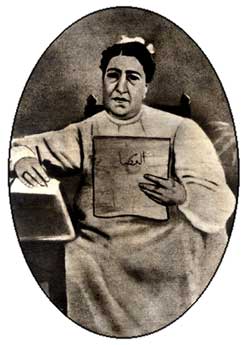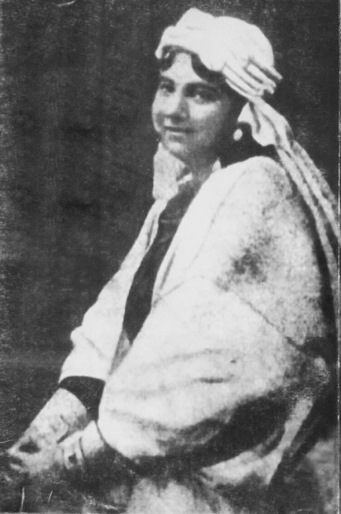Ola Al-Tanani is the maternal great granddaughter of Aziza Al-Gayyar, one of the women who took to the streets of towns and cities across Egypt 100 years ago to take part in the demonstrations of the 1919 Revolution.
It was only a few years back during a family discussion on women’s rights that Al-Tanani came to learn about the association of her family with political resistance and women’s rights, however.
At a screening of a documentary at the American University in Cairo (AUC) on 2 March, Al-Tanani spoke about Al-Gayyar and her role in the 1919 Revolution.
In her 30s and a development communications expert, Al-Tanani said that the story of her family showed that it had not been easy for young women, even those like Al-Gayyar from the upper middle classes, to participate in protests.
“She was around 15 years old at the time and was attending high school, but her family was upset by what they thought of as an irresponsible attitude and decided that she should no longer be allowed to go to school and that she should be married off,” Al-Tanani said.
A few days later there came her first suitor. “Al-Sayyed Ramadan, my paternal great grandfather, was also at the protests. He saw her, and he later proposed to her, and soon enough they were wedded,” Al-Tanani said.
The documentary is a production of the AUC’s Adham Centre for Television and Digital Journalism. “We made the documentary as part of our work to celebrate 100 years of the 1919 Revolution, which coincides with the centenary of the AUC,” said Lina Al-Ghadban who oversaw the making of the film by a group of students attending her class on documentary film-making.
When Al-Ghadban first offered the assignment to the class, the students were not immediately interested, however. “They were apprehensive; they did not immediately relate to the topic; but as they got down to work, they got to see that what they were doing is very important because there is a huge shortage of documentation related to the 1919 Revolution,” Al-Ghadban said.
The documentary, entitled Al-Hekayah (The Story), offers a glimpse of some of the known and unknown people who took part in the demonstrations of March 1919.
“I guess there is a lot that remains unknown, particularly about the women of this era, those who were there for the revolution even when they were not necessarily there in the revolution,” said Sahar Al-Mogi, a novelist and professor of English literature at Cairo University.
In her recent awarded-winning novel Misk Al-Tal (Musk of the Hill), Al-Mogi does her part to complete the drawing of the character of a single woman closely associated in the minds of many with the 1919 Revolution — Amina, the seemingly timid and helpless spouse of Ahmed Abdel-Gawad, the lead character of Naguib Mahfouz’s Bein Al-Qasrein (Palace Walk), the first part of his celebrated Cairo Trilogy of novels.
In the novel by Mahfouz, originally published in 1956, Amina loses her son to the bullets of police trying to stop the demonstrators from calling for the independence of Egypt from British occupation.
Amina is not allowed to bid her son farewell because as a woman she was not allowed to be at his funeral.
In the novel by Al-Mogi, which came out in 2017, Amina comes to life again in the later part of the 20th century and seeks out her son’s grave where she has the plants watered. She finds herself an apartment nearby, and she becomes a friend, mentor and guide to younger women after the elapse of much of the 20th century.
“I realised that even though it was not there in Mahfouz’s novel, Amina must have had a fuller character. This was very inspiring for me because it shows that at the time women might have looked timid on the outside, but they were not without their own inner strength and resolve,” Al-Mogi said.

Aïcha Taymour
Women In Fiction
However, it was not just Mahfouz who did not dwell in his trilogy on the characters of the women, Al-Mogi argued. There is also not much that has been written on the women of that time in modern and contemporary Egyptian literature, she added.
She makes an exception for a novella by prominent Egyptian physician Mustafa Musharafa entitled Kantara aladhi Kafar (Kantara who lost his Faith) that offers an account of a man who lived through the 1919 Revolution and had conflicting moments of faith and doubt.
Musharafa also presents a woman from a more popular background than Amina who is not subdued by the patriarchal expectations of her time.
This presence of resourceful women in the years of the 1919 Revolution, Al-Mogi added, is also clearly seen in the late Egyptian journalist Salah Eissa’s book Rigal Raya wa Sekina (Men of Raya and Sekina), a socio-political narrative about the women and men associated with the lives of two sisters executed in 1921 after having been indicted for theft and homicide.
With very little documentation existing about these two women, Eissa went through the legal files to throw light on the lives of Raya and Sekina who left the heavily impoverished Upper Egypt of the second decade of the 20th century to come to Alexandria to try to escape poverty and oppression.
“One gets to see a fuller picture of the women of the times that goes beyond just the prominent figures of the 1919 Revolution,” Al-Mogi said.
She agreed that another part of the picture is there in Mahfouz’s novel in the shape of Galila, a singer and dancer who uses her wit and that of her assistant artists to entertain Abdel-Gawad and others.
For Al-Mogi, Galila is one of the powerful women of her times. “There were certainly others,” she said.
In a book on the art of Egyptian singing in the early 20th century, a former dean of the Higher Institute for Arabic Music in Cairo also reflects on the role of Mounira Al-Mahdia, a diva of the time, in promoting the 1919 Revolution, not just through her performances attended by the rich and the growing middle classes, but also through activism that included interventions to secure the release of freedom-fighters and hosting political meetings in her boathouse.

Malak Hefni Nassef
“All these segments were part of the bigger picture of women’s presence not just during the 1919 Revolution but even before that and certainly after,” said Hala Kamal, an AUC professor of gender studies.
Kamal acknowledged that there was an Egyptian women’s movement prior to 1919 led both by women of the upper classes like Hoda Shaarawi, a leading figure of the revolution who offered ground-breaking ideas about the role and rights of women, and by middle-class figures like Aïcha Taymour who wrote in Arabic, not in French, and therefore had a wider influence.
“They presented the first list of women’s demands to parliament in 1910 almost a decade prior to the revolution,” Kamal said. It was woman activist Malak Hefni Nassef, who died a few months before the 1919 protests, who read out these demands.
As Kamal added, it was this presence that prompted the Wafd Party that was established in 1918 by politician Saad Zaghloul to consider the fate of the nation after World War I to include figures from the women’s movement of the time, especially after the participation of women in the protests in March 1919.
“Hundreds of women took part in a meeting leading up to their participation in the 16 March protests where St Mark’s Cathedral stands in Cairo today. When they went out, they were faced by the police, and some women, essentially from the middle classes, died in the demonstrations,” Kamal said.
“The 1919 Revolution came some years after the graduation of the first high school students from the Al-Saniya School for Girls and after women had started to enter what we now know as Cairo University,” she added.
The growing feminist movement of the time had considerable influence, especially as it tried to win over the committee that wrote the country’s 1923 constitution to incorporate women’s rights and focus on their right to education and the protection of their rights in marriage. These demands were only partially met, however.
Kamal said that this was essentially the first wave of Egyptian feminism, but that this continued until the 1952 Revolution, fundamentally with the same demands, with increasing calls being made for the right to political participation and for equality in the work place.
In 1956, the new republic granted women many of their demands. “But as part of the mood of nationalisation, the feminist movement of the time was almost nationalised by the state. This continued until the 1980s when a third wave of feminism in Egypt was inspired by the role of civil society,” Kamal said.
Women’s demands, Kamal added, continued to revolve around an essential list that was expanding and evolving as women were taking on more visible roles in society and as times were changing.
Eventually, there came a fourth wave of feminism, still unfolding, when women decided to assume a larger presence on the political scene with their direct participation in demonstrations calling for political freedoms in 2005.
This continued until the 25 January Revolution and beyond, “with a firm accent on citizenship rights, human rights, and women’s rights,” she said.
“What started with a feminist movement calling for the age of consent for marriage to be set at 16 is evolving now into demands to criminalise marital rape and to raise the age of marriage for women at 21,” Kamal said.
The strength of the Egyptian feminist movement, Kamal agreed, was never strictly in the making of its leading figures but came from the strong influence of prominent artistic figures like Al-Mahdiyah and then Tahiya Karioka, a belly-dancer and actress, and the faith of the population as a whole represented in Al-Gayyar.
“The leaders were at the centre of the picture, but the full picture has many others in it. For leaders to be able to make change, they need the support of some and the following of others,” argued Al-Tanani.
Inevitably, Al-Mogi said, the story of women in and around the 1919 Revolution is still missing many parts. However, many of these are now being gathered through archival research and completed in literary work, she added.
* A version of this article appears in print in the 7 March, 2019 edition of Al-Ahram Weekly under the headline: Women’s power, then and now
Short link: